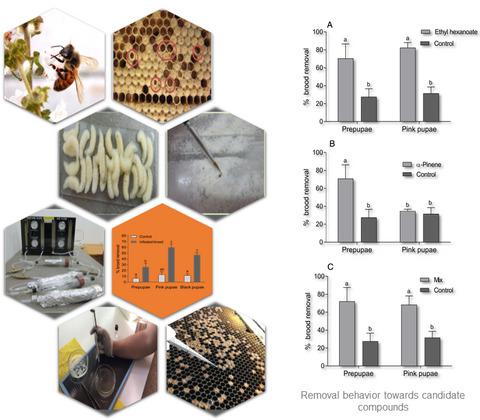当前位置:
X-MOL 学术
›
Entomol. Exp. Appl.
›
论文详情
Our official English website, www.x-mol.net, welcomes your feedback! (Note: you will need to create a separate account there.)
Temporal changes in volatile profiles of Varroa destructor-infested brood may trigger hygienic behavior in Apis mellifera
Entomologia Experimentalis et Applicata ( IF 1.9 ) Pub Date : 2021-03-16 , DOI: 10.1111/eea.13048 María Clara Liendo 1 , Irina Muntaabski 1 , Romina María Russo 1 , Silvia Beatriz Lanzavecchia 1 , Diego Fernando Segura 1 , María Alejandra Palacio 2 , Jorge Luis Cladera 1 , Patricia Carina Fernández 3, 4 , Alejandra Carla Scannapieco 1
Entomologia Experimentalis et Applicata ( IF 1.9 ) Pub Date : 2021-03-16 , DOI: 10.1111/eea.13048 María Clara Liendo 1 , Irina Muntaabski 1 , Romina María Russo 1 , Silvia Beatriz Lanzavecchia 1 , Diego Fernando Segura 1 , María Alejandra Palacio 2 , Jorge Luis Cladera 1 , Patricia Carina Fernández 3, 4 , Alejandra Carla Scannapieco 1
Affiliation

|
Varroa destructor Anderson & Trueman (Acari: Varroidae) is one of the major contributors to the significant losses of western honey bee, Apis mellifera L. (Hymenoptera: Apidae), colonies worldwide. Hygienic behavior, in which individual workers detect, uncap, and remove unhealthy brood, is a type of social immunity that reduces pathogen and parasite loads in the colony. Previous evidence suggests that hygienic worker bees identify diseased brood through olfactory cues. The aims of the present work were (1) to study the hygienic behavior of worker bees toward V. destructor-infested cells at different stages of brood development, (2) to explore changes in brood volatile profiles associated with the progression of mite infestation, and (3) to analyze the role of specific volatile compounds in triggering the hygienic behavior. Results showed that the removal rate of infested brood changed along its development and the progression of mite reproduction. Two compounds, ethyl hexanoate and α-pinene, were present in volatile collections from mite-infested pupae but absent from uninfested pupae. Field bioassays showed that these volatiles are relevant to elicit the hygienic behavior. A third compound, β-ocimene, was present in infested and uninfested brood but its abundance pattern varied according to the infestation status throughout brood development. Specifically, for uninfested brood, the abundance of β-ocimene showed a reduction in black-eyed pupae, whereas for infested brood, its abundance decreased drastically in light-pink-eyed pupae and remained constant in black-eyed pupae. Our results revealed that olfactory signals associated with V. destructor infestation change as the reproductive cycle of V. destructor progresses inside the cell. These changes can be mimicked to some extent by adding specific volatile compounds to the cell to induce hygienic removal. These findings shed light on the chemical basis of hygienic behavior against V. destructor and could facilitate the development of improved hygienic selection tools to breed mite-resistant honey bee colonies.
中文翻译:

Varroa破坏者侵染的雏鸡挥发性概况的时间变化可能会触发蜜蜂的卫生行为
Varroa的破坏者Anderson&Trueman(Acari:Varroidae)是造成全球殖民地西部蜜蜂Apis mellifera L.(Hymenoptera:Apidae)大量损失的主要原因之一。卫生行为,其中每个工人都可以检测,发现并清除不健康的血统,是一种社会免疫,可减少菌落中的病原体和寄生虫负荷。先前的证据表明,卫生工蜂通过嗅觉提示识别出患病的雏鸡。本研究的目的是(1)研究工蜂对V. destructor的卫生行为。-在幼虫发育的不同阶段感染细胞,(2)探索与螨虫侵袭有关的幼虫挥发性概况的变化,以及(3)分析特定挥发性化合物在触发卫生行为中的作用。结果表明,受侵害的亲鱼的去除率随其发育和螨的繁殖进程而变化。螨虫侵染的p的挥发物中存在两种化合物,即己酸乙酯和α-pine烯,而未虫侵染的up则不存在。现场生物测定表明,这些挥发物与引起卫生行为有关。在成虫和未成虫的亲鱼中都存在第三个化合物,即β-烯菊酯,但其丰度模式根据整个亲鱼发育过程中的侵害状况而变化。具体来说,对于未受感染的亲鱼,β-ocimene的丰度显示黑眼p的减少,而受侵染的亲鱼的浅粉色眼的its的丰度急剧下降,而黑眼p的丰度则保持恒定。我们的结果表明,嗅觉信号与五,析构函数为患变化的生殖周期V.析构函数在细胞内进行。通过向细胞中添加特定的挥发性化合物以诱导卫生去除,可以在某种程度上模拟这些变化。这些发现阐明了针对弧菌的卫生行为的化学基础,并且可以促进开发改良的卫生选择工具来培育抗螨虫蜂群。
更新日期:2021-05-22
中文翻译:

Varroa破坏者侵染的雏鸡挥发性概况的时间变化可能会触发蜜蜂的卫生行为
Varroa的破坏者Anderson&Trueman(Acari:Varroidae)是造成全球殖民地西部蜜蜂Apis mellifera L.(Hymenoptera:Apidae)大量损失的主要原因之一。卫生行为,其中每个工人都可以检测,发现并清除不健康的血统,是一种社会免疫,可减少菌落中的病原体和寄生虫负荷。先前的证据表明,卫生工蜂通过嗅觉提示识别出患病的雏鸡。本研究的目的是(1)研究工蜂对V. destructor的卫生行为。-在幼虫发育的不同阶段感染细胞,(2)探索与螨虫侵袭有关的幼虫挥发性概况的变化,以及(3)分析特定挥发性化合物在触发卫生行为中的作用。结果表明,受侵害的亲鱼的去除率随其发育和螨的繁殖进程而变化。螨虫侵染的p的挥发物中存在两种化合物,即己酸乙酯和α-pine烯,而未虫侵染的up则不存在。现场生物测定表明,这些挥发物与引起卫生行为有关。在成虫和未成虫的亲鱼中都存在第三个化合物,即β-烯菊酯,但其丰度模式根据整个亲鱼发育过程中的侵害状况而变化。具体来说,对于未受感染的亲鱼,β-ocimene的丰度显示黑眼p的减少,而受侵染的亲鱼的浅粉色眼的its的丰度急剧下降,而黑眼p的丰度则保持恒定。我们的结果表明,嗅觉信号与五,析构函数为患变化的生殖周期V.析构函数在细胞内进行。通过向细胞中添加特定的挥发性化合物以诱导卫生去除,可以在某种程度上模拟这些变化。这些发现阐明了针对弧菌的卫生行为的化学基础,并且可以促进开发改良的卫生选择工具来培育抗螨虫蜂群。


























 京公网安备 11010802027423号
京公网安备 11010802027423号